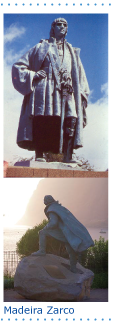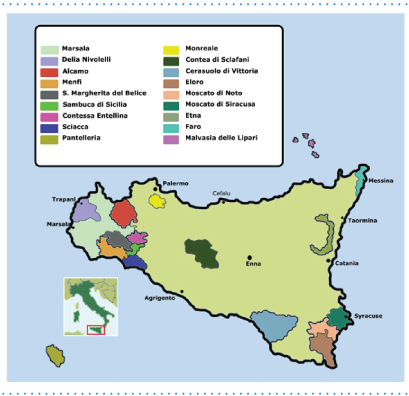|

...Continued from previous page
MADEIRA
Madeira is delicious, adventurous, and the longest lived fortified wine. Bottles of Madeira from 1795 have recently been poured by the glass at a few top restaurants. Imagine drinking a bottle of wine that was made during the presidency of George Washington!
In Shakespeare’s Henry IV, the Prince of Wales is accused of selling his soul for a glass of Malmsey (Madeira) and a chicken leg. Thomas Jefferson, George Washington, John Adams, and Benjamin Franklin all enjoyed Madeira. The inauguration of George Washington as President, Washington chosen as the capital city, and the writing on the Declaration of Independence were all historic moments marked with a glass of Madeira.

The island of Madeira, where the fine fortified wine is made, was discovered by Joao Goncalves Zarco ‘the one eye’ or ‘the squinter.’ Yep, a rugged old warrior pirate of a man discovered the island that makes the refined and posh Maderia. When his ship neared the island he described "there hung over the sea a thick impenetrable darkness, which was guarded by a strange noise." They believed they had founds the gates to Hell.
Good old Zarco populated the island with prisoners and grape vines. Madeira takes its name from the Portuguese word for wood, as the island was covered with ancient trees. Legend has it that he accidentally set the island on fire and that it burned for seven years. All the charred tree ashes helped to create the rich fertile soil of Madeira. The islands location well off the Southern Portuguese coast in the Atlantic Ocean made it an ideal stopping point for travel to the West Indies the New World, England, and many other destinations. Originally an unfortified table wine, the wines of Madeira frequently traveled on Dutch East India Company boats to India. The long hot voyage transformed the wines into something even more spectacular. Vinho da Roda was a type of early Madeira that aged on a ship for a round trip to India and back. By the 1800’s estufas, or hot rooms, were created to simulate this voyage and transform the wine of Madeira into Madeira. Alcohol was added to protect the wine from breaking down, and this practice was standard by the 1750’s.
There are five main grapes used in Madeira production and each has its own unique style and classification. Sercial and Verdelho are fermented until almost dry and then fortified. Bual and Malmsey are fortified earlier in fermentation.
• Sercial- this is the driest and tastes of almonds (.5-1.5% RS)
• Verdelho- moderately sweet and smokey (1.5-2.5% RS)
• Bual- Sweet and raisiny (2.5-3.5% RS
• Malmsey- The sweetest with nutty and grapey flavors (3.5-6.5% RS)
• Tinta Negra Mole- the most widely planted grape on the island, but only used in the production of bulk Madeira. It is fermented dry and then fortified.

Madeira can be made in three ways:
• Wine is in a concrete vat, and hot water (as hot as 122F/50C) circulates through a coil submerged in the vat. The maderization process takes 3 months, and then it is sweetened and fortified. This is the cheapest and fastest method.
• Wine is in a cask, and fortified prior to heating for a more integral flavor. An estufa (or oven at 85-105F/30-40C) heats a hot room, called a Armazens de color, for 6 to 12 months.
• Fortified wine is aged in a cask in a non-temperature controlled warehouse. This process takes several years, and is an expensive lengthy process.
The resulting wine should be 17-18% ABV.
MARSALA
Marsala is made on the Italian island of Sicily in both sweet and dry styles. Catarratto, Grillo, and Inzolia are the grape varietals used and the blend is fortified during fermentation. Marsala production began in Sicily when a British lover of Sherry, Port, and Madeira named John Woodhouse noticed that Sicily had a good climate for fortified wine production. Marsala can be fortified in two different ways: Grape spirit can be added or late picked must mixed with alcohol (sifone) can be added. Marsala can also fall into three color catergories: Oro (golden) Ambra (amber- sweetened by mosto cotto or concentrated must), and Rubino (ruby).
 Marsala is categorized into sweetness level in the following way: Secco (dry)- 4% RS Marsala is categorized into sweetness level in the following way: Secco (dry)- 4% RS
Semisecco (semidry)- 4-10% RS
Sweet- more than 10% RS
Marsala is categorized according to aging regimen:
Marsala Fine- minimum 1 year aging Marsala Superiore- minimum 2 years aging Marsala Superiore Riserva- minimum 3 years aging Marsala Vergine/Marsala Solera- minimum 5 years aging- cask solera system Marsala Vergine Stravecchio Riserva- minimum 10 years aging- cask solera system
MALAGA
Continuing our tour of fortified wines, we return to Andalusia, Spain (home of Sherry) where Malaga is made. Malaga was incredibly popular in the 17th century, and by the mid-19th century, vine plantings here were so extensive as to be Spain’s second largest wine region. Remember that Spain’s La Mancha region is not only Spain’s largest, but the largest region in all of Europe. The double defeat of powdery mildew and phylloxera devastated the region and it never quite recovered. There are now about 14 bodegas making Malaga today, where there were well over 100 at the height of its popularity.
Pedro Ximenez, Airen, and Moscatel de Alejandria are the grapes used to create Malaga wine. Grapes were dried on straw mats, which reduced the water content and concentrates the flavors. Malaga can still be made in this way. These wines are aged in a solera system within the city of Malaga. They can range from 15-23% ABV and can be finished either dry or sweet.
MONTILLA-MORILES
Montilla-Moriles is very similar to Sherry. It is also a region in Andalusia, Spain located just north of Malaga. It is made in Fino and Oloroso styles- the first with flor and the second without. Added complexity and integration of flavors that the solera system provides in Sherry is utilized here too. Fortification takes place after fermentation. The main point of differentiation is that Pedro Ximenez, Airen, and Moscatel Alejandria are the main varietals used in Montilla-Moriles production. Pedro Ximenez is the dominant grape planted here, and can reach 14-16% ABV without fortification.
VIN DOUX NATURELS
This is a broad term to describe a French wine whose fermentation is arrested by the addition of neutral grape spirit. Typically, they are made from the Muscat family of grapes or Grenache. This technique of arresting fermentation with neutral grape spirits to kill off the remaining yeasts that results in a wine with high alcohol and residual sugar may sound familiar. This is the same fortification process for Port, Madeira, Marsala, and Malaga. This process was originally mastered 400 years before Port was ever produced by Arnaldus Villanova in 1299 at Monpellier University’s Medical School. The neutral spirit added to make VDN’s is a higher percentage (95% ABV compared to Port’s 77% ABV neutral spirit) but less is added and the resulting wine is around 15% ABV.
In the Languedoc, the VDN’s made are Muscat de Frontignan, Muscat de Lunel, Muscat de Mireval, Muscat de St.-Jean-de-Minervois. In the Rousillon Muscat de Rivesaltes, which is Muscat based as the name suggests, and Grenache based VDN’s Banyuls and Maury. Muscat de Beaumes de Venise and Grenache based Rasteau are the VDN’s of the Rhone.
|
